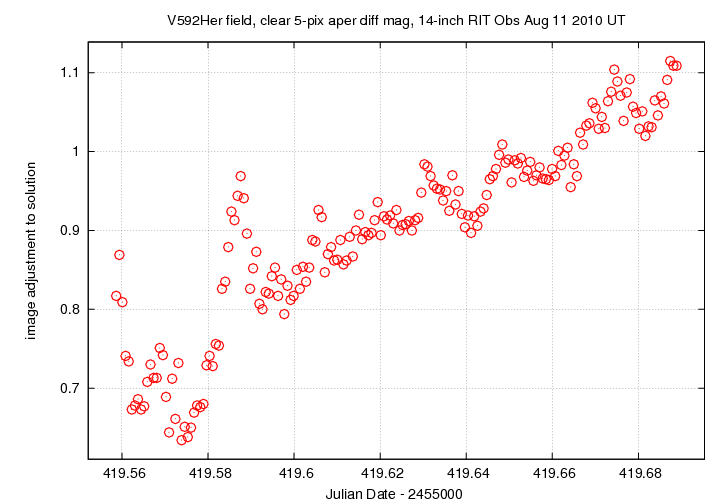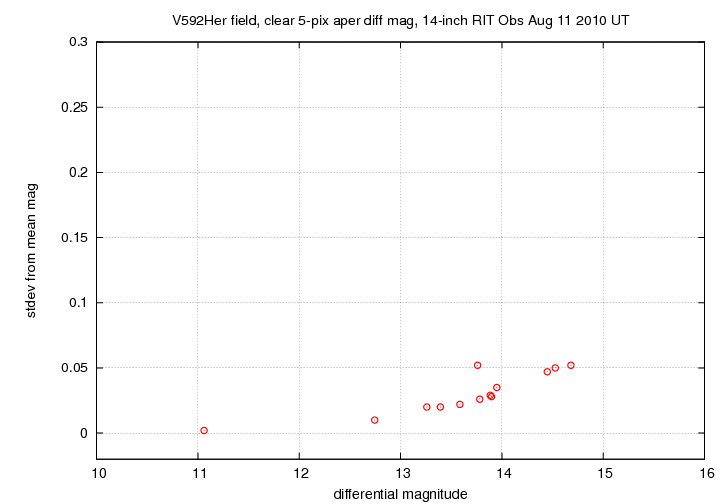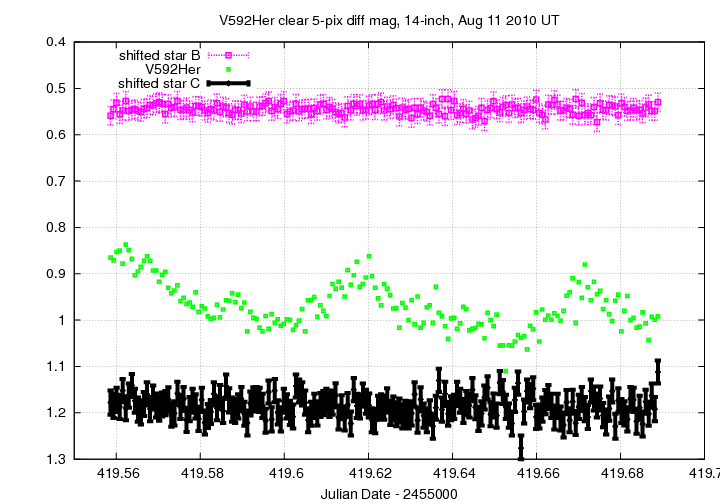
On the night of Aug 10/11, 2010, I observed the cataclysmic variable star V592 Her in outburst. My measurements show that it had an average magnitude of about V=15.4, with variation about 0.15 mag peak-to-peak. The star has faded by about 0.3 mag from its brightness three nights ago, and its variation has decreased a bit.
The setup was:
Notes from the night
This is a chart of the field based on an image from Aug 08 UT. The field of view is about 9 arcminutes on a side.

I measured the instrumental magnitude of each star with aperture photometry, using a radius of 5 pixels = 5.3 arcseconds and sky defined by an annulus around each star. Following the procedures outlined by Kent Honeycutt's article on inhomogeneous ensemble photometry, I used all stars available in each image to define a reference frame, and measured each star against this frame.
One output of the ensemble solution is the value of the zero-point of each frame relative to the others. In the graph below, I plot this zero-point as a function of time. Note the gradually increasing value, due to clouds.

Below is a graph of the scatter in differential magnitude versus magnitude in the ensemble solution.

The floor of this diagram is hard to judge: there's one very bright star, "A", which dominates the solution. Its scatter is only 0.002 mag, but that is probably misleadingly small. The next-brightest star has a scatter of 0.010 mag.
The star with very elevated scatter near differential magnitude 13.8 is the target, V592 Her. No other stars in the field show significant variation.
Light curves for selected stars (V592 Her and stars A - F) in the field are shown below. The target is shown by light green crosses.

Below is a closeup of the light curve of V592 Her and a couple of comparison stars (which I have shifted vertically for convenience).

I've made a table of the measurements themselves, with three different flavors of time. The differential magnitudes from the ensemble solution have been shifted so that star "A" in my chart, USNOB1.0 1112-0258663, has value 12.784, which is its V-band magnitude according to Henden's calibration.
Here's the start of the table.
# Measurements of V592Her made at RIT Obs, Aug 11, 2010 UT, # in mediocre conditions, # by Michael Richmond, using 14-inch Celestron and SBIG ST-9E CCD. # Exposures 60 seconds long, no filter. # Tabulated times are midexposure (FITS header time - half exposure length) # and accurate only to +/- 1 second (??). # 'mag' is a differential magnitude based on ensemble photometry # using a circular aperture of radius 5.3 arcseconds. # which has been shifted so USNOB1.0 1112-0258663 has mag=12.784 # which is its V-band magnitude according to Henden via AAVSO. # # UT_day JD HJD mag uncert Aug11.05865 2455419.55865 2455419.55964 15.388 0.026 Aug11.05938 2455419.55938 2455419.56037 15.394 0.026 Aug11.06009 2455419.56009 2455419.56108 15.376 0.026
Last modified 8/11/2010 by MWR.